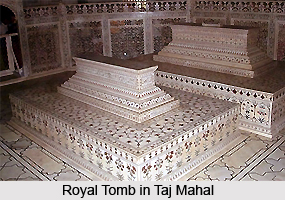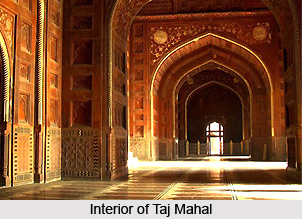Architecture of Taj Mahal is one of the finest specimens of artistry in India. The efforts and dexterity of Indian architects during the Mughal rule had found magnificent expression through the meticulous and brilliant elements that compile to form this extraordinary structure. Located in Agra, Uttar Pradesh, it was built by the Mughal emperor Shah Jahan as a dedication to his third wife Mumtaz Mahal. Architecture of Taj Mahal exhibits a combination of Persian, Islamic, Ottoman Turkish and Indian styles. The eminent architecture of this stunning monument enlisted it among the World Heritage Sites. Taj Mahal is in fact a compilation of several structures, each having admirable beauty. The construction of this monument began in 1632 and continued up to 1653. The basic elements of construction were white marble and precious gemstones.
 Tomb Architecture of Taj Mahal
Tomb Architecture of Taj Mahal
The central focus of this beautiful structure is the tomb made of white marble. This large tomb is housed on a square plinth and has typical Persian elements. It`s most attractive feature is the large marble dome surmounting the tomb and a finial at the top. At the four corners of the plinth, there are four minarets framing the tomb. The dome top is embellished with a lotus design. The dome is also known as onion dome because of its shape. Amalgamation of Hindu and Persian elements of decoration can be observed in the finial which was originally created by gold but was later replaced by bronze. A moon with its tips pointing towards heaven, a typical motif of Islam, tops the finial. In Muslim culture, personal sanctity can be achieved by visiting the resting place of the venerated in Islam.
Exterior Architecture of Taj Mahal
Magnificent Mughal architecture decorates the exterior of Taj Mahal. Different types of craftworks including stone inlays, stone carvings, paintings and stucco had conferred beautiful architecture to Taj Mahal. The designs and motifs on the exterior of Taj Mahal can be categorized as abstract, calligraphy and vegetative patterns. Passages from Quran can be prominently witnessed among the decorations. Calligraphy work of Taj Mahal comprises of thuluth script, inscribed on white marble panels. Abstract paintings can be found on different parts of the monument including minarets, gateways, plinth, and mosques and on the surface of the tomb. Floral and geometrical motifs are also painted on different parts of the structure.
 Interior Architecture of Taj Mahal
Interior Architecture of Taj Mahal
Interior architecture of Taj Mahal is a little different from the traditional style and is adorned with precious gemstones. The inner chamber has an octagonal shape with entry door at each of it faces. However, the door towards the south, which faces the garden, is only used. The chamber has a false dome with sun motifs made on them. Intricate decoration of graves is forbidden in Muslim tradition for which the dead bodies of Shah Jahan and Mumtaz were placed in simple crypts where their faces were turned towards Mecca, in their right side. The grave of Mumtaz Mahal is placed on a rectangular base of marble. Precious gemstones embellish the base and calligraphic inscriptions on the casket are made in the praise of Mumtaz. Caskets of men and women have icons of pen box and writing table, which are the icons of funerary in Mughal tradition.
Paradise Garden (Charbagh) of Taj Mahal
Paradise garden is a Persian concept brought about by Mughal, derived from Persian Timurid gardens. The garden beholds many symbolisms. Paradise garden, also known as charbagh is a square garden which is equally divided into four equal parts. The four parts of the garden are further divided into sixteen flowerbeds with the help of raised pathways. There is a central water tank made of marble that reflects the mausoleum. Trees and fountains decorate the garden in the most artistic manner. As per traditional Islamic texts, a paradise is a garden with an abundance of flowers, plants and trees.
Outlying Structures of Taj Mahal
Red sandstone walls surround the three sides of Taj Mahal except the side facing the river. Several other mausoleums stand outside the walls which belong to Shah Jahan`s other wives and one of the favourite servants of Mumtaz. The principal gateway of Taj Mahal is made of marble and is highly decorated with typical Mughal Architecture.
The Architecture of Taj Mahal is the best testament of the excellent artistry of Mughal age. A board of architects, under imperial supervision, designed this beautiful monument. Combination of beautiful structural elements and balanced craftworks had furnished exquisite beauty to it. Tourists from all over the world come to visit Taj Mahal which is absolutely a visual treat. Taj Mahal represents zenith of art and beauty in the Mughal reign.




